| | | 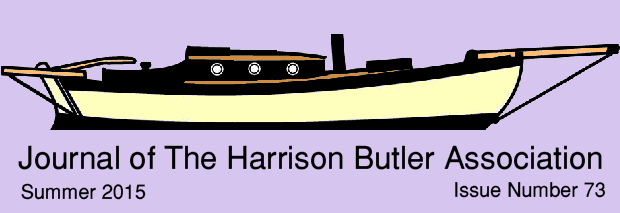
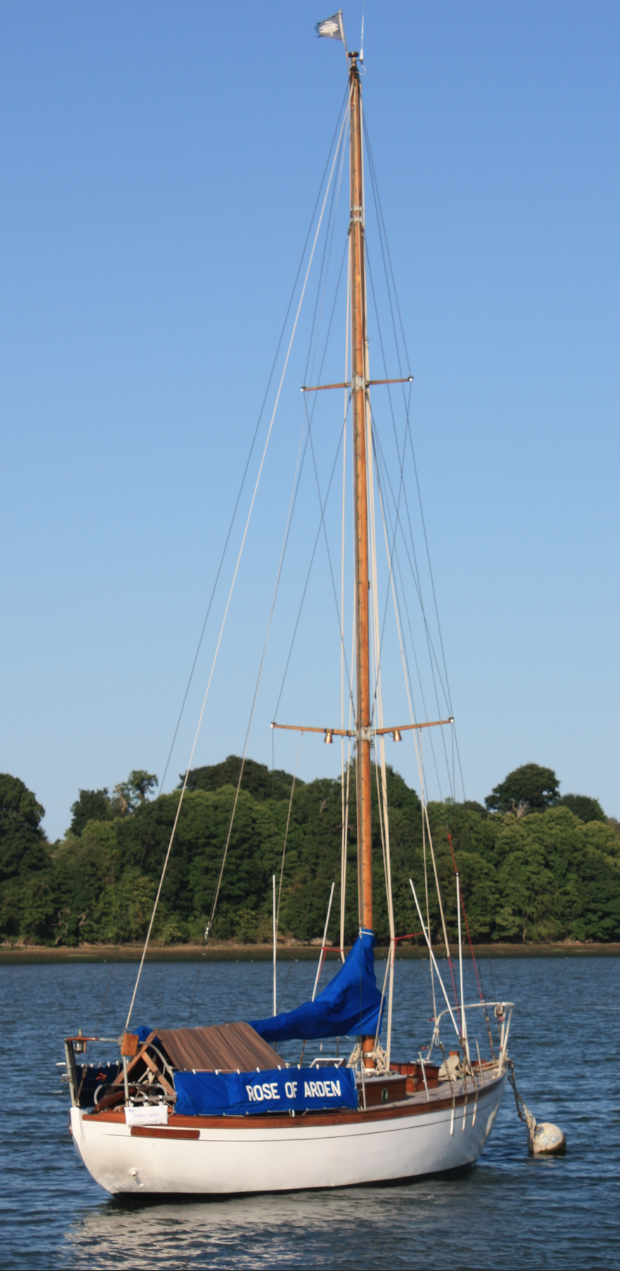
Moored on the River Orwell, Rose of Arden bathed in summer sun.
She's owned by Andrew Cocks, the new HBA Yearbook editor.
Photograph by Martin Hansen
The Journal of The Harrison Butler Association
Editor : Martin Hansen
Proof Reading : Dr Helen Jones
Far East Correspondent : Dr Stephen Davies
Australian Correspondent : David Stamp
Netherlands Correspondent : Michiel Scholtes
Baltic Correspondent : Myriam Spicka
UK Correspondent for The Solent : Robert Griffiths
UK Correspondent for Dartmouth : Allen Clarke
Contributions for the Journal are most welcome be they
fully formed articles, rough notes or snippets of News.
If you feel you would like to contribute on a regular basis,
applications to join our growing network
of correspondents are also invited.

When I bought the 80 year old Harrison Butler designed boat, Tramontana, it seemed quite natural that she came equipped with two anchors from days gone by. The oldest was what all land lubbers immediately recognise as being an anchor; a genuine Admiralty Pattern or Fisherman's anchor. I refuse to believe that this was ever used in earnest to attach my vessel to the sea bed for it is awkward to handle and has a reputation for being next to useless as a small yacht anchor, except on a sea bed strewn with rocks. It immediately became an ornament in my home.
The second anchor aboard Tramontana, set up and ready to drop, was a CQR, the design of which dates from 1933. Unlike the Fisherman, the CQR is treated as an anchor to be considered seriously in my up-to-date Yachtmaster text book. This is embarassing, for it indicates that the RYA Yachtmaster syllabus is lagging behind the times. The CQR is good in the mud of Essex, where the design was invented and tested by mathematician Geoffrey Taylor. However, it is widely aknowledged that it may need to be dragged up to 50 meters along less favourable sea beds before setting, and is likely to break out when the direction of pull upon it is reversed by strong wind or tide. In spite of its poor reputation, I've used the CQR three times. It held during a three day period of calm weather in Devon's Eldeberry Cove and overnight in a more lively sea off Caldy Island, near Milford Haven. However, I spent an uncomfortable night listening to it scraping along the sea bed off Shoreham in the English Channel. The Force 3 wind blew Tramontana 400 metres further out to sea during the night with 50 metres of chain and the CQR anchor dragging along the sandy sea bed behind us, failing to properly arrest our drift. At first light I cursed it, hauled it up, and went on my way.
Last week, I took a careful look at what anchors the other sailing boats in Penarth Marina, my home port, were using. Disconcentingly, almost without exception, they had a CQR on their bow rollers. And yet almost any discussion or article about anchors being used in earnest condemns the CQR as not being good enough. With Tramontana about to head to the wild waters off the west coast of Scotland this summer, I have decided to embrace the fact that, in the 82 years since the CQR was designed, anchor technology has moved on.
After much research, I've bought a Vulcan anchor, so new you may well not have heard of it, as it's only been available since November 2014. Essentially, it's a spade anchor, a design from the 1990s, brought right up to date. I'm looking forward to trying it out in some remote and exciting anchorages.

Fisherman, CQR and Vulcan anchors

!•¡•! The buying and selling season for 2015 has kicked off with the exquisite and expensive Almonde (asking price £31,000) changing hands via the De Valk Yacht brokerage in the Netherlands. As the Journal went to press, we received news that the sale of Diana (asking price £7,500) has been finalised.
!•¡•! Production of the 2015 edition of the HBA Yearbook has stalled due to problems in transferring the database of membership information between former editor Peter Crook and the new editor Andrew Cocks. Hopefully, the problems will be resolved soon as members have not had a Yearbook since 2013.
!•¡•! The owner of the 'pink star' Zyklon called Zyclon, Peter Vandenhirtz, has been in touch with photographs and information about this 'lost' boat. Peter's article about Zyclon will feature in the Autumn 2015 issue of the HBA Journal.
!•¡•! It's taken a while to sort out, but the HBA website resources page is now active. The intention is to bring together, in one compact place, information of relevance to the owners of Harrison Butler designed boats.
!•¡•! In Cobber, HBA Chairman, John-Henry Bowden will be attending the Birdham Classic Boat Festival on July 11th/12th. He writes, "There will be refreshments, music and classic cars plus mooring is free for any classic boat dressed overall. Birdham Marina is 6 miles from the Chichester Harbour entrance and can be entered 3.5 hours either side of Portsmouth high water via a lock which runs on free flow near the top of spring tides. The Marina ask that any boat intending to come notify them on 01243 512310".
John-Henry would be glad to see members at the festival. He is also on the look out for a HBA member willing to be his crew on Cobber for the short sail to and from the event. Contact johnhenry.and.marilyn@gmail.com or 01273 401464.

The St George's Day Trophy 2015
~ Classic Boat Racing at Yarmouth ~
Robert Griffiths
The HBA's UK Correspondent for The Solent
On 9th May 2015 a crew of myself, my son, Alex, and my brother in law, Jon, entered Lindy II in The St Georges Day Trophy 2015. This event is actually held over the two weeks following St George's day and is hosted in style by The Royal Solent Yacht Club at Yarmouth, Isle of Wight. It is a small event and was set up for pilot cutters with charter crews. Other traditional craft (gaffers, lugers and Bermudan rigged boats over 70 year of age) are invited to attend and all boats race together using Gaffer's Association Handicaps.
This was only the second classic racing event I have entered with Lindy II. On her previous outing, at last year's Falmouth Classics, it was apparent that her cutter rig has insufficient headsail area for fast upwind sailing. I had acquired a lot of old sails with the boat and decided to look through these for inspiration. Almost all were completely worn out, but there was a large Genoa that did not seem to have had much use. I discovered it measured 210 sq feet and is as large as Lindy II's mainsail. Perhaps this would be the answer to the lack of headsail power.

Lindy II's Captain, Robert Griffiths
On the day of the regatta the wind was blowing force 6+ and I decided that with little practice with this sail we would have to revert to the cutter rig. However, the strength of wind led to the start being postponed. After a rain squall passed through the wind dropped and the forecast was given as force 5/6 dropping to force 3/4. The race officer decided to go ahead with the event. At this point the racing red mist came down and I decided to hank on the untried Genoa with a one reef main and not use Lindy II's mizzen and this is how we lined up for the off. The gaffer's handicapping system does not measure headsail area (only the fore triangle area) and not using this area to full advantage adversely effects boat speed without gaining any compensation in the handicap rating.
We achieved good starts and the Genoa worked well giving us good upwind speed. It was exciting being in racing company with the pilot cutters. We beat them on the water in one race except for the largest, Jolie Brise. This historic boat is known for being the winner of the first Fastnet race. She is 56 feet on deck and is quite a sight coming up from behind especially when close together rounding a mark. Cross tacking with such a large boat heightened the excitement, and even more so when we realised the Jolie Brise was heeled so far over that her propeller was completely out of the water. I was later informed I had not noticed that she has an offset propeller that is easier to see when she is on her port tack.
It was all going really well for us; then came the last race. Some while after the start the wind started rising. With our large Genoa we became seriously over pressed while reaching as well as beating. Lindy II heeled over so far the leeward side decks remained under water and we were glad for her high cockpit coamings. The wind climbed to a force 7, with touches of force 8. Lindy was going faster than I had ever known and I was pleased to find that the helm remained well balanced. Unfortunately we soon started to notice that the bowsprit whisker stays were becoming slack and the bowsprit was visibly flexing. This was of concern, as it would surely break before long. Over the radio we heard that due to the increase in wind the race would end the next time we went through the finish gate. This was two legs away, a beam reach and a beat. The red mist descended again and as we would have to beat back anyway I decided to risk completing the race. The reach was faster than ever with the log indicating 8 knots. The heeling of the boat must have increased her water line length allowing her to exceed hull speed. At this point the power on the Genoa sheet caused the bronze sheet fairlead track to shatter with a loud bang. Luckily the irreplaceable bonnet fairlead remained on the sheet and the crew were able to run the sheet through another fairlead enabling us to finish.
We were certainly glad to complete the course and the sails were straight down and the engine on as soon as we crossed the finish line. Back in Yarmouth harbour it became clear that the rig tension, caused by the wind strength and large foresail, had caused the cranse iron (the ring at the end of the bowsprit to which the stays are attached) to ream its way over an inch down the bowsprit and cause the whisker stays, bobstay and forestay to slacken. Oops ! On the plus side the aged teak decks looked wonderful for such a good dousing with salt water. Possibly a rather expensive way of washing the decks but I would never have achieved such a great look with a bucket and mop.
A significant part of entering this type of event is the good fun of joining in with the other competitors in social events. The event dinner and prize giving was a sociable evening where we received considerable banter for being the boat with the spare mast, as the mizzen sail had remained stowed on the boom. We made lots of new acquaintances. When the results were announced we were placed a creditable 2nd place ahead of larger craft but behind Foxhound, our class winner. Foxhound was built in 2001 and, although she looks like a 100 year old gaff rigged boat, she benefits from modern design knowledge and was noticeably faster than us.
The following day the wind had eased allowing us to risk the poorly stayed bowsprit on our return to Emsworth, escorted by a fellow competitor, the Cornish Crabber Pilot Cutter Alice Pellow, also based in the same harbour as Lindy II.
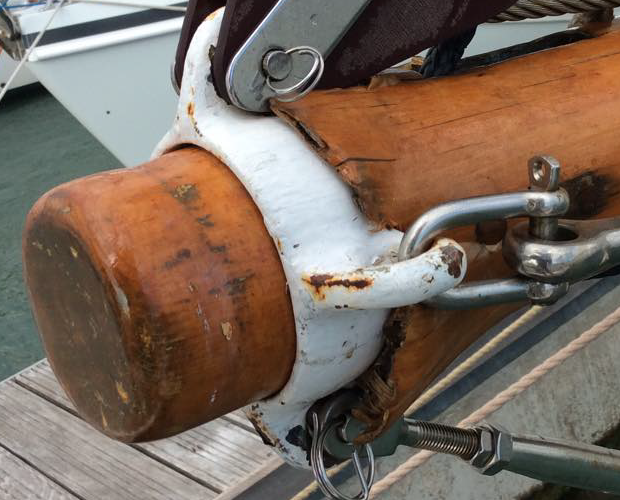
Lindy II's bowsprit after the race in Force 7 winds.
The cranse iron ring has reamed its way down the bowsprit.
Amiri's Burgee
David Stamp
The HBA's Australian Correspondent
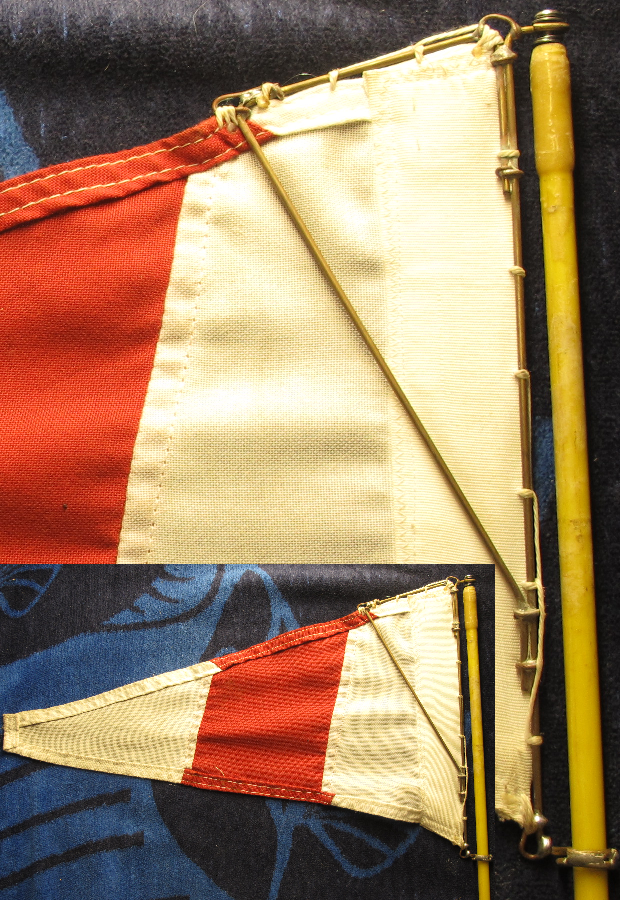
Amiri's Sandringham Yacht Club burgee has thought, time and effort behind it.
The sprit/gaff rig supports the fly of the burgee and prevents
it from wrapping around the stick when there is no wind.
The fly is truncated a bit to prevent it colliding
with Amiri's wind-indicator as it is hoisted.
The Philosopher's Boat
From Tramontana's Log
2014 : July : 22nd : Tuesday
A mid-morning water taxi took Tramontana's four crew down river to Dartmouth leaving me, the skipper, aboard. With the afternoon to myself I secured the new outboard to the tender. In tropical sunshine I sped off up the Dart to see if I could find Zenocrate, a Harrison Butler Z4. About three cables above the Greenway Landing (for Agatha Christie's house) I found her, engine running to recharge batteries. New owner Graham Room, a Professor of European Social Policty at the University of Bath, welcomed me aboard with cider and cake. He bought Zenocrate because she was built for the English philosopher and historian, RG Collingwood (1889-1943) who had written his autobiography (about his ideas) in a three month period aboard her in 1938. Graham told me that he relished sitting in Zenocrate's cabin, writing where the great man had done likewise all those years ago.

Graham Room aboard Zenocrate on the river Dart

A Confession
~ Mary Gray & “The Incident” ~
Tom Riddell

Enough time has elapsed that I can confess to a silly mistake on the way home from last year's Harrison Butler Summer Meet at Newtown River. Ruth (my crew) and I had a fabulous day on Mary Gray. It was our first outing with the Harrison Butler Association and it was a real thrill seeing all the other boats. We rafted up next to Tramontana which dwarfed Mary Gray and felt very secure. After meeting everyone on the shingle spit and enjoying the barbeque, we left for Lymington a little later than planned, which meant we were a bit over optimistic about getting back as quickly as expected once the tide ran against us. I do know how to sail technically, having grown up racing dinghies in Australia almost every summer weekend from age 8 to 22 or so. However most of the places we raced, we didn't have to consider tides, mud banks, shingle banks, shipping or any buoys other than the racing marks, so I've a lot to learn on the Solent.
On the way back to Lymington we beat into a fairly stiff south westerly, and once the tide started running against us progress was relatively slow. We tacked up close to the East End shore where the tide charts suggest the water runs a bit slower. At 6.30 pm, when we were about 200 metres east and inshore of the starting platform which marks the Lymington channel, I took down the sails and started to motor. Trouble hit almost immediately. I ran over a fishing buoy which stopped the motor and moored Mary Gray firmly stern to the tide and chop. I had seen that we were among fishing buoys but did not allow for just how fast we were going sideways with the tide as we motored out to go around the starting platform. Fortunately a Yanmar 1GM is no match for a piece of mooring rope, and nothing was broken, but we were firmly stuck, with visions of not getting home for my wife's birthday dinner. I could just reach the fishing buoy line when Mary Gray went down in a trough between the chop, because the propeller is offset to the port side. However I was so concerned that I didn't even think of cutting the line and sailing in, which seems so obvious in retrospect.
I rang the Harbour Master to ask if he would help. He kindly sent out one of the young officers, Tom Bell, in a reasonably powerful outboard, saying that given how small Mary Gray was, he would assess the position and if he felt he could resolve it, he would. Tom said he was very pleased to be sent out as it made a good change from working in the office. After sorting out the tow line he asked me to cut the fishing net free, and towed us gently into the chop and back to the marina. I was very relieved. As my friends showed no sign of ever letting me forget it, the fishing buoy, once untangled from the propeller, was installed as a garden ornament, a permanent reminder to be a bit more careful in future.
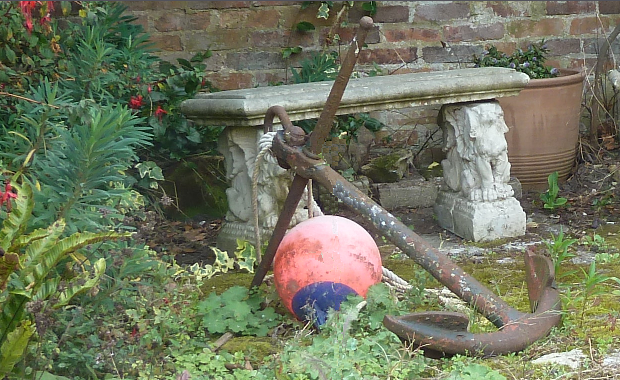
The buoy that snared Mary Gray, now a garden ornament
The Shortest Harrison Butler Designed
Boat To Cross The Atlantic
Martin Hansen
The HBA's Webmaster & Journal Editor
Harrison Butler's Tabloid N°16 design won first prize in a Yachting Monthly design competition in 1929 for “a sailing cabin cruiser for at least two persons, 18 feet on the water line and fitted with an auxiliary engine”. Three boats are known to have been subsequently built to the design, Elgris, Ballerina and Va Danser.
Elgris was constructed by Fox & Son of Ipswich in 1933 and is still in existance all-be-it in poor condition as a restoration project in Cornwall. The date that Ballerina was built in New Zealand is not known, although she too has not strayed far from her original home, last spotted there in 2008.

A scan of an advertisement from the July 1933 edition of Yachting Monthly,
offerring Va Danser, possibly then called Bonveen, for sale
Va Danser was built in Carantec, in North Brittany in 1932. Very little is known about her except for the fact that in 1957 this tiny vessel sailed across the Atlantic. This extraordinary achievement is mentioned in several French sailors' logs and memoirs but is unappreciated by the English speaking world. Consider this; Va Danser's waterline length of 18 feet is actually less than that of the boats that in recent years have won acclaim for being rowed across the Atlantic. Charlie Pitcher's trans-atlantic solo in 2013, for example, was in a 6.5 metre boat, a little over 21 feet in length. It is debatable whether operating oars or sails is the greater challenge on such a small floating platform in the open sea.
The Man
Bernard Kohler bought Va Danser specifically to sail across the Atlantic. He was strong-willed rather than skilled, navigating without a log to measure his speed or a sextant to determine his position.
The Voyage
Bernard left Concarneau, Brittany, on 27th August 1957 and headed straight across the Bay of Biscay with Va Danser steering herself. After three days he was off Cape Finisterre, the north-west corner of Spain. The next two weeks were spent fighting headwinds which necessitated long periods on the helm. He recorded that “I applied my needle diligently, mending one sail whilst the other tore”. On the 15th September Va Danser sailed into La Luz, Gran Canary, where he met Jean Bluche, a fellow French sailor at the start of a circumnavigation in his boat, Chimère. Jean wrote, “Everything on Va Danser was soaking wet, Bernard's mood very low. He tried to sell Va Danser but couldn't find a buyer”.
After six weeks, Bernard had mustered the strength to continue. With Va Danser rolling heavily, but sailing herself once more, he headed south. It took him four weeks to find the trade winds but from that point on, he started clocking up 24 hour runs of almost a hundred miles. He'd left the Canary Islands on 28th October and arrived in St Lucia on 7th December: 40 days at sea.
The Boat
Harrison Butler produced several designs with a waterline length (LWL) of 18 feet and, indeed, his most popular design, the Z4, has only one foot more. A few of his designs have less LWL but, even so, it seems unlikely that Bernard Kohler's crazy record will be bettered. The Bon Marché design of 1921, for example, has a LWL of 16 feet, but the only known example, Faoileag, has not been heard of since 1985. With Earth's climate change seemingly resulting in a more turbulant atmosphere of higher and more frequent strong winds, it may well be an impossible record to break.
For the voyage, Va Danser was modified with the addition of moveable panels to protect the otherwise open cockpit and provisioned with 120 litres of water. In 1957 there was, of course, no GPS and weather forecasting was more of an art than a science.
The Harrison Butler Association has no record of what has happened to Va Danser or Bernard Kohler since this epic voyage. Nor do we have a photograph of either the boat or the man. Prior to 1957 it is believed Va Danser was called Bonveen. Should any reader know more, please get in touch.
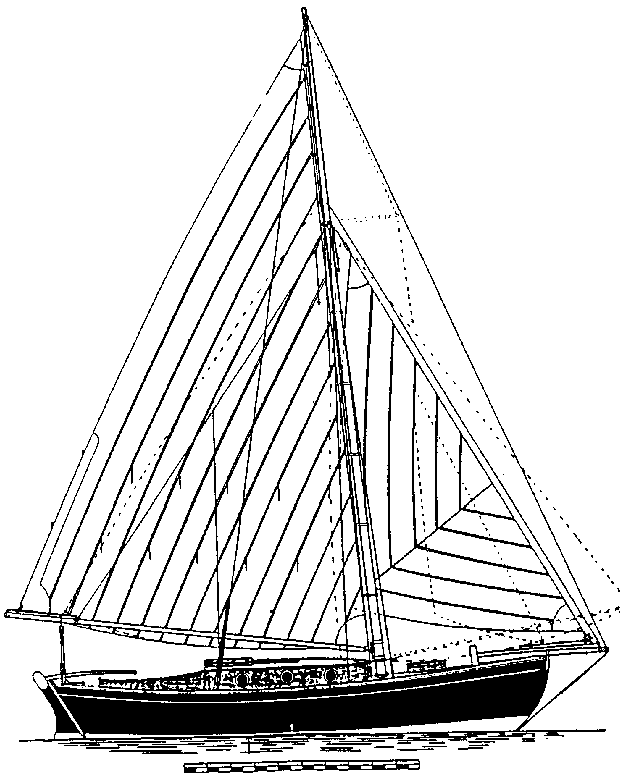
Va Danser
The shortest Harrison Butler designed boat to cross the Atlantic

Chiquita : Z4 : 1939 : Devon, UK : £2,750
Cyclone : Cyclone Design : 1941 : Netherlands : £11,000
Jane : Bogle Design : 1939 : Cornwall, UK : £10,000
Jolanda : Omega Design : 1996 : Germany : £25,000
June : Z4 : 1939 : Scotland : £3,500
La Bonne : Nursery Class : 1919 : Devon, UK : £POA
Saltwind : Z4 : 1940 : Spain : £16,000
Senorita : Cyclone II Design : 1934 : New Zealand : £4,000
Tamaroa : Thuella Design : 1973 : £9,000
Thule : Yonne Design : 1934 : Netherlands : £15,000 -£18,000
Watermaiden : Rose of Arden Design : 1939 : Cornwall, UK : £17,500
Witte Walvis : Z4 : 1939 : Netherlands : £5,000
Zebedee : Z4 : 1938 : Ireland : £4,750
Zenocrate : Z4 : 1938 : Devon, UK : £5,950
Zephon : Z4 : 1950 : Shetland, UK : £4,500

| |














